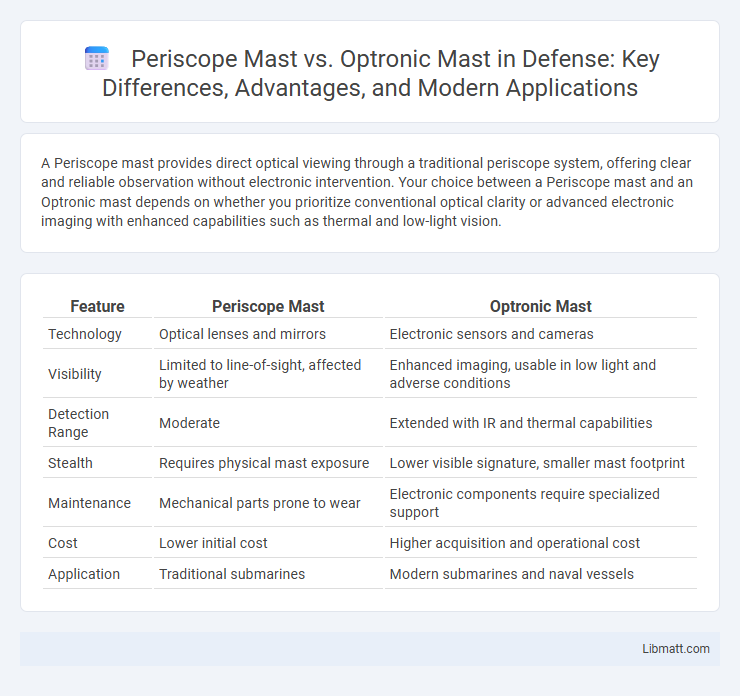A Periscope mast provides direct optical viewing through a traditional periscope system, offering clear and reliable observation without electronic intervention. Your choice between a Periscope mast and an Optronic mast depends on whether you prioritize conventional optical clarity or advanced electronic imaging with enhanced capabilities such as thermal and low-light vision.
Table of Comparison
| Feature | Periscope Mast | Optronic Mast |
|---|---|---|
| Technology | Optical lenses and mirrors | Electronic sensors and cameras |
| Visibility | Limited to line-of-sight, affected by weather | Enhanced imaging, usable in low light and adverse conditions |
| Detection Range | Moderate | Extended with IR and thermal capabilities |
| Stealth | Requires physical mast exposure | Lower visible signature, smaller mast footprint |
| Maintenance | Mechanical parts prone to wear | Electronic components require specialized support |
| Cost | Lower initial cost | Higher acquisition and operational cost |
| Application | Traditional submarines | Modern submarines and naval vessels |
Introduction to Submarine Masts
Submarine masts play a critical role in underwater navigation and surveillance, with periscope masts traditionally providing optical viewing capabilities above the water surface. Optronic masts, equipped with advanced electronic sensors and high-resolution cameras, offer enhanced imaging, night vision, and radar capabilities without the need for direct optical alignment. Your choice between these masts influences operational effectiveness in terms of stealth, situational awareness, and technological integration during submerged missions.
What is a Periscope Mast?
A Periscope Mast is a traditional, retractable sensor system used on submarines to provide optical observation above the water surface without exposing the vessel. Unlike Optronic masts that use digital cameras and sensors, Periscope Masts rely on direct optical lenses and mirrors to deliver real-time visual data. Your choice between these masts depends on the need for classic optical clarity or advanced electronic imaging capabilities.
What is an Optronic Mast?
An Optronic mast is an advanced sensor system used on naval vessels and submarines, replacing traditional periscope masts with digital imaging technology. It integrates high-resolution cameras, infrared sensors, and laser rangefinders to provide enhanced situational awareness without the need for physical hull penetration. This technology allows for discreet surveillance and targeting, improving operational capabilities while reducing vulnerability.
Key Functional Differences
Periscope masts use traditional optical lenses to provide visual observation above the waterline, relying on physical movement and alignment for image capture. Optronic masts incorporate electronic sensors such as infrared cameras, low-light detectors, and laser rangefinders to deliver enhanced imaging capabilities and real-time data integration. Your choice depends on whether you prioritize classic visual clarity or advanced multispectral surveillance and target acquisition.
Technological Advancements
Periscope masts have evolved from traditional optical systems to incorporate digital imaging sensors and high-resolution cameras, enhancing situational awareness with improved clarity and range. Optronic masts utilize advanced electro-optical technologies, integrating infrared sensors and laser rangefinders for superior night vision and target acquisition capabilities. Your choice depends on the need for stealth and multi-spectrum surveillance, with optronic masts offering cutting-edge technological advancements for modern naval and surveillance applications.
Visual and Sensor Capabilities
Periscope masts offer traditional optical viewing with high-resolution lenses for direct visual observation, primarily relying on visible light sensors. Optronic masts integrate advanced multispectral sensors, including infrared and thermal imaging, enhancing target detection and situational awareness in low-visibility conditions. Your choice depends on whether you prioritize classic optical clarity or advanced sensor fusion capabilities for comprehensive surveillance.
Tactical Advantages and Limitations
Periscope masts offer a traditional optical method for submarine observation, providing high-resolution visual intelligence with minimal electronic emissions, which reduces the risk of detection. Optronic masts leverage advanced sensors such as infrared and low-light cameras, enabling enhanced situational awareness in various environmental conditions and extending detection ranges beyond visible light. However, periscope masts are limited by their physical exposure and stability requirements, while optronic masts depend on complex electronics that may be vulnerable to electronic countermeasures and require greater power consumption.
Impact on Submarine Design
Periscope masts require direct optical paths and rotating mechanical components, imposing structural constraints and limiting hull design flexibility in submarines. Optronic masts use electronic sensors and cameras without the need for physical periscope tubes, enabling lower mast profiles and increased internal space for systems and crew. This transition enhances stealth capabilities and allows more streamlined submarine designs with improved hydrodynamics and operational efficiency.
Operational Use Cases
Periscope masts excel in traditional naval reconnaissance by providing high-resolution optical imaging and situational awareness above the water surface, ideal for submarines during stealth operations. Optronic masts offer enhanced multifunctional capabilities, including infrared, low-light, and laser rangefinding sensors, making them indispensable for modern naval vessels requiring versatile surveillance in varying environmental conditions. Your choice between the two should prioritize mission-specific needs such as stealth requirements, sensor diversity, and the operational environment for optimal situational intelligence.
Future Trends in Submarine Masts
Future trends in submarine masts emphasize enhanced sensor fusion and reduced detectability, with Periscope masts evolving towards compact designs incorporating advanced photonics and digital imaging. Optronic masts increasingly integrate high-resolution electro-optical sensors and infrared cameras, enabling superior situational awareness without direct visual exposure. Your submarine's surveillance capabilities will benefit from these advancements, combining stealth and multi-spectral intelligence for demanding underwater operations.
Periscope mast vs Optronic mast Infographic

 libmatt.com
libmatt.com